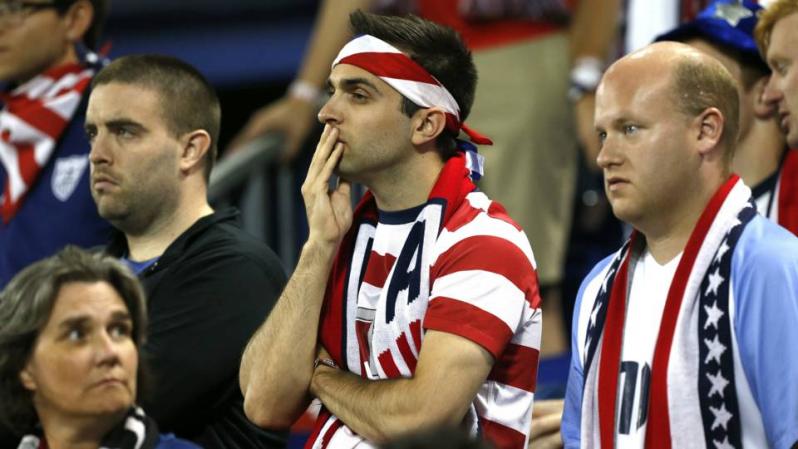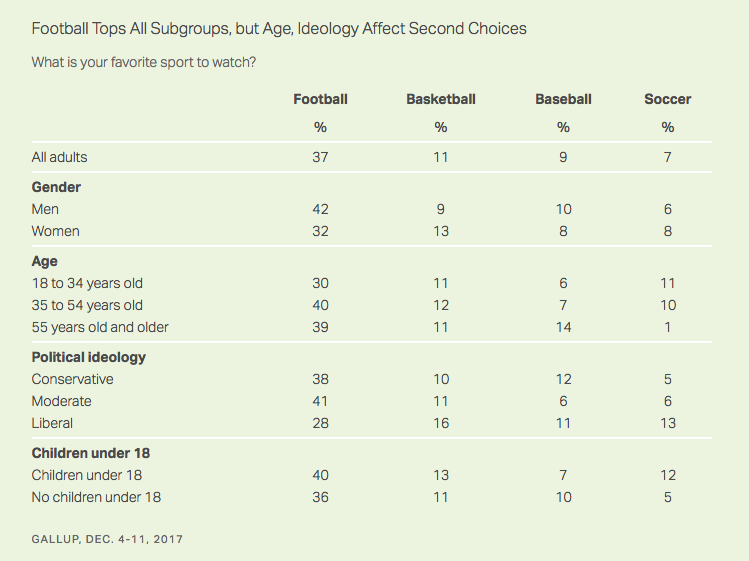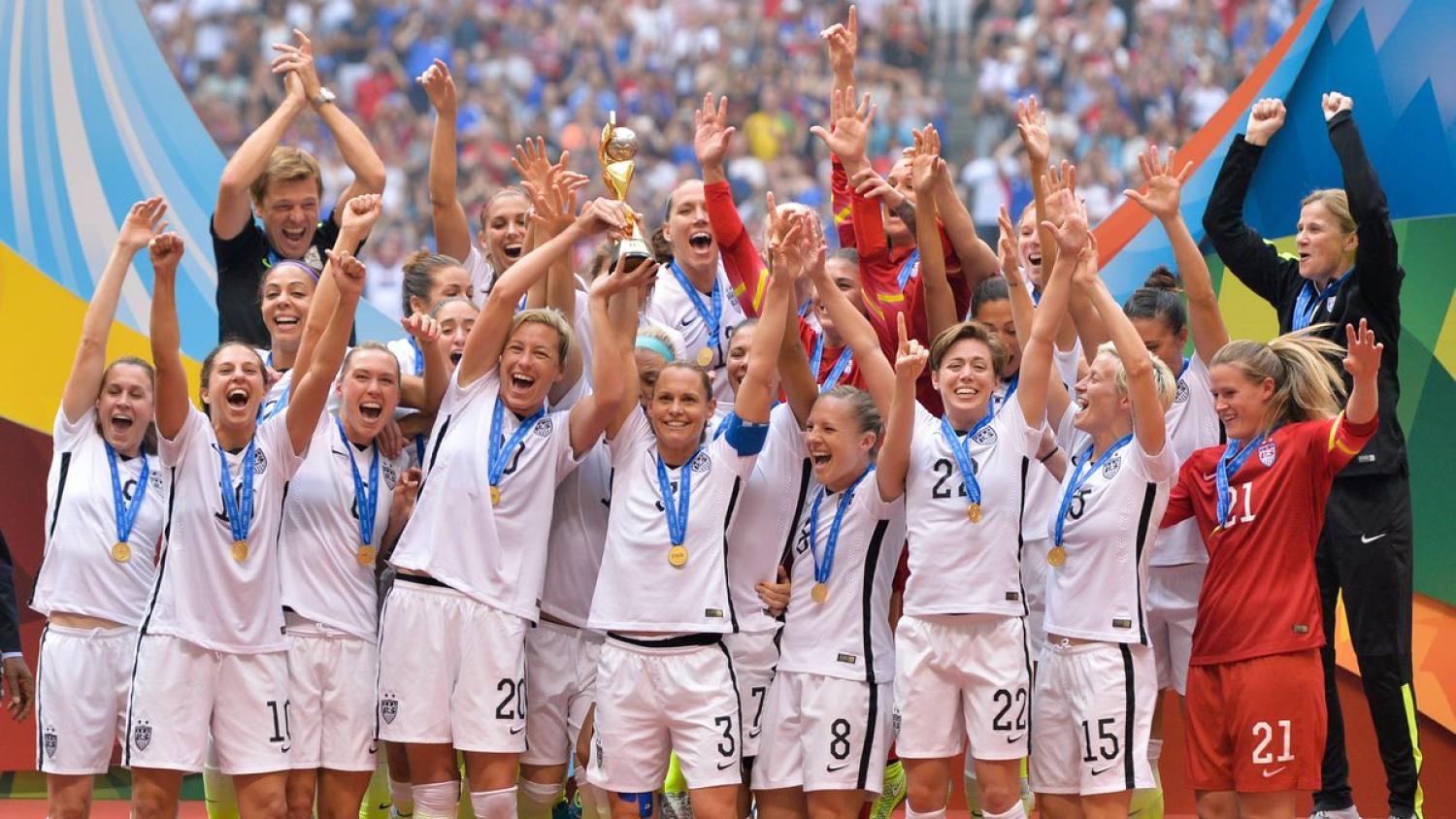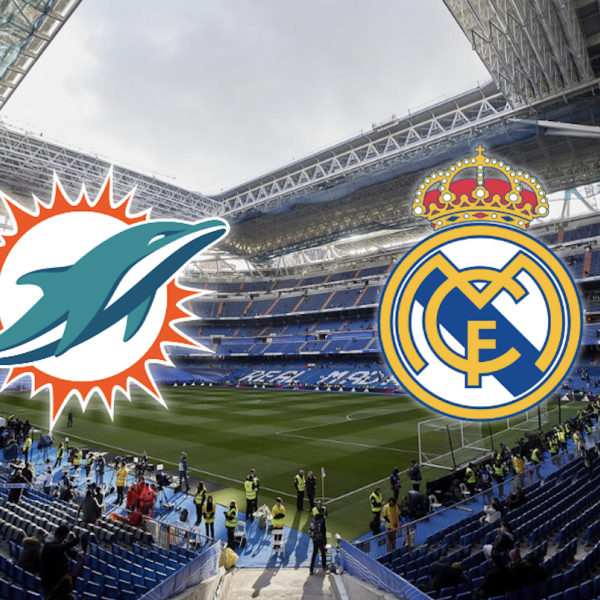Every so often you see a story or a headline about how soccer is taking over the U.S. — it’s been America’s sport of the future for at least four decades. The latest stories revolve around a recent Gallup poll, which asked Americans what their favorite sport is to watch. Soccer popularity in America is ranked fourth, easily passing by hockey and inching closer to edging baseball out of the top three.
American football still reigns supreme in the land of anthem kneeling and concussions, garnering 37 percent of the responses. This number is in decline, down from 43 percent 10 years ago, but still higher than the 30 percent it had 20 years ago. Basketball and baseball have both seen steady declines over a 20-year period.
The key here is the sport picking up the most steam is soccer. In 1997, the year after Major League Soccer debuted, soccer came in with 2 percent of the vote, less than auto racing (7 percent), golf (5) and hockey (3) and equal to tennis, boxing and ice/figure skating. Soccer was still at 2 percent in 2007, but that number doubled to 4 percent by 2013.

Source: Gallup
The most recent Gallup poll, from December of 2017, has soccer at 7 percent, two points behind third-place baseball, which is at its lowest point ever at 9 percent. No fourth-place sport has reached the 7-percent mark since auto racing in 1997. Never has football, basketball or baseball been so threatened to drop out of the top three.
U.S. soccer laureate Grant Wahl bought into the hype generated by the poll.
More on the fascinating new Gallup poll that shows soccer is closer than any sport ever to cracking the Big 3 of Americans’ favorite spectator sports https://t.co/A4zw3UfEx8 pic.twitter.com/T9rXS4C6WQ
— Grant Wahl (@GrantWahl) January 9, 2018
So clearly soccer is finally ascending to mainstream status on the American sports scene, right? Well, not quite.
There’s no doubt soccer popularity in America continues to grow. Even with the shocking failure to qualify for the 2018 World Cup, appetite for soccer both domestically and from abroad continues to increase. More and more Americans are choosing to play soccer over brain-damaging American football, height-precluding basketball or boring baseball.
The Gallup poll numbers show a clear trend for soccer as opposed to baseball, which has gradually declined since polling at 39 percent of Americans’ favorite sport in 1948. Soccer is finally getting out of the 1-3 percent portion it’s been stuck in since the ’80s. It should be noted that the one choice that has grown more than soccer in the last 20 years is the amount of people not having a favorite sport, going from 6 percent in 1997 to a whopping 15 percent in 2017.
But an important aspect to remember here is the way in which the question was asked. Gallup asked “What is your favorite sport to watch?” Not: “What is your favorite sport?” to include the idea of actually participating or even a pluralized version of “What are your favorite sports to watch?” but a single-choice question based on either going to a game or sitting in front of a television.
The single-choice aspect is the most important. Many American football fans are also fans of plenty of other sports, but merely rank football as their top choice. Plus, both American football and basketball have various leagues (collegiate and professional) that garner different (though often overlapping) audiences.
In an October poll asking merely whether or not people are fans of certain sports, soccer ranked ninth in popularity, behind even hockey and auto racing.

Source: Gallup
This October poll, which was inclusive, allowing respondents to choose as many sports as they want, shows how far soccer has to go in the U.S. While 28 percent of those polled said they were a fan (a 5 percent increase from 2012), the fact that number ranks behind every other major sport in the country is a bit deflating for all those proclamations of soccer catching baseball as the third-most popular sport in the country.
One merely has to look at attendance figures to make this point. Major League Baseball brings in around 70 million fans to baseball stadiums each season compared to around eight million for Major League Soccer. The NFL, which has far fewer games, has around 17 million fans in attendance in a given year, but leads every sport in average attendance close to 70,000.
Anyone who followed the 2016 U.S. presidential election can tell you: Polls aren’t exactly straightforward. It’s easy to sensationalize a story like this one and make sweeping conclusions over one piece of data, but it’s never that simple. It’s not just about what the numbers say, but how the question was asked and how the data is compiled.

Soccer popularity in America isn't straight forward. Photo: @sportingnews | Twitter
The December Gallup poll questioned 1,049 adults living in the U.S., giving it a margin of sampling error of ±4 percentage points. That’s not to say soccer popularity in America could be as high as 11 percent or as low as 3 percent, but it does suggest some ambiguity in the results, as in any poll. Add in the exclusive nature of the question itself, and it’s easy to see where wrong conclusions can be made.
It’d be easy to look at the single snippet of data and assume soccer is more popular than auto racing, hockey and even closing in on baseball, but it simply is not the case. Data shows 51 percent of Americans are fans of baseball compared to 28 percent being fans of soccer. Just because more of those soccer fans pick soccer as their favorite sport doesn’t make soccer more popular than baseball in this country.
All that said, soccer is undoubtedly growing. The biggest takeaway from the recent Gallup poll shouldn’t be that soccer is catching up to baseball, but that soccer is polling higher in key demographics.

Source: Gallup
Soccer ranks behind only American football in popularity among 18- to 34-year-olds, well ahead of the aging baseball crowd. Only basketball has a higher percentage of women amongst fans of the most popular sports. In this instance, inclusivity of a different nature benefits soccer’s status as a sport of the future.
Soccer popularity in America is trending upward, but it’s unfair to both soccer and other sports in America to categorize it as anything more than it is. There’s still a long way to go before soccer can rival even baseball in America, despite what the numbers may appear to say.








